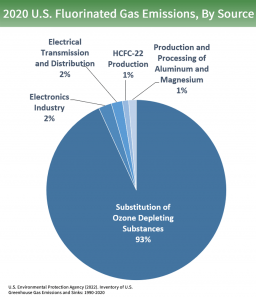Request A Quote
Our business is most valuable when it helps our customers. Please fill out the form with as much detail as possible so we can respond with the most helpful solution.
Fluorinated greenhouse gas emissions account for about two percent of emissions in the United States and emissions are growing. F-gases, as they are called, are the most potent and persistent of the greenhouse gases. These gases are generally thousands of times more effective than CO2 at trapping heat in the atmosphere, and many remain in the atmosphere for millennia. Due to their high global warming potential, relatively small quantities of these gases can yield large greenhouse gas emissions in CO2–equivalent terms.
Main uses of F-gases:

All emission estimates from the Inventory of U.S. Greenhouse Gas Emissions and Sinks: 1990–2020.
Unlike other greenhouse gases, fluorinated gases have no significant natural sources and come almost entirely from human-related activities. They are emitted through their use as substitutes for ozone-depleting substances. Many fluorinated gases have very high global warming potentials (GWPs) relative to other greenhouse gases, so small atmospheric concentrations can have disproportionately large effects on global temperatures. They can also have long atmospheric lifetimes—in some cases, lasting thousands of years. Like other long-lived greenhouse gases, most fluorinated gases are well-mixed in the atmosphere, spreading around the world after they are emitted. Many fluorinated gases are removed from the atmosphere only when they are destroyed by sunlight in the far upper atmosphere. In general, fluorinated gases are the most potent and longest lasting type of greenhouse gases emitted by human activities.
Our business is most valuable when it helps our customers. Please fill out the form with as much detail as possible so we can respond with the most helpful solution.